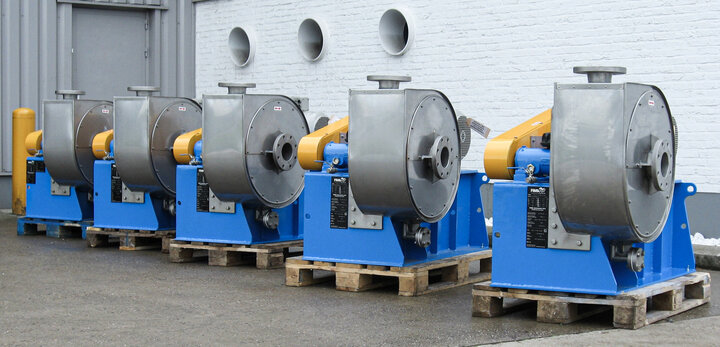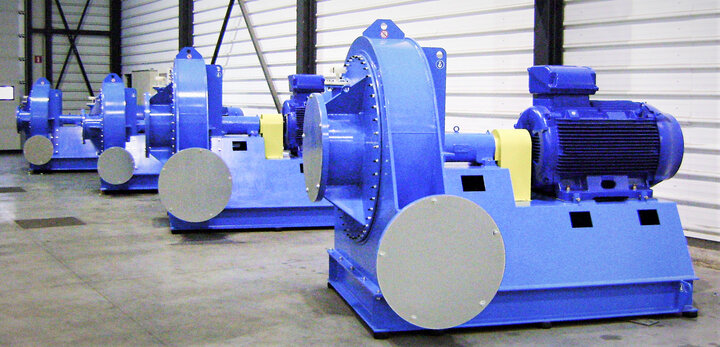Serafimas Radial Fans
When air or process gases need to be moved purposefully through high resistance, centrifugal fans (radial fans) are an efficient solution. Compared to axial fans, centrifugal fans offer improved performance in terms of the required pressure increase. They are used wherever there is a large increase in pressure. As a component of modern ventilation technology, centrifugal fans are used, for example, for targeted temperature regulation, ventilation and dehumidification of systems in industry, medicine and private households.
Centrifugal fans and their use
Industrial fans in process gas plants have to overcome higher resistances, such as filters, with limited air flow. Centrifugal fans can be compared to a drum. They draw in the air or process gas via the motor axis and blow it out again offset by 90° (radially). In contrast to axial fans, centrifugal fans are also suitable for larger pressure increases with a constant air volume. Due to the flatter characteristic curve compared to axial fans, a centrifugal fan is more tolerant of increases in pressure drop, e.g. due to gradually fouling filters. They are used for transporting and extracting gas, steam and dust.
Basically, a distinction is made between centrifugal fans with and without scroll housing. Centrifugal fans with scroll housing direct the air into a piping system. Centrifugal fans without scroll housing, on the other hand, merely circulate the air or process gas.
The classic applications of centrifugal fans in industry include chemical or petrochemical plants, but also plants in the food, pharmaceutical or steel industries. They are also suitable for extracting air in commercial premises or factory halls. A powerful centrifugal fan can also be used in agriculture, for cleaning or for optimal drying of materials.
Types and mode of operation of centrifugal fans

Centrifugal fans are characterized by their centrifugal, dynamic mode of operation. Conventional models consist of an impeller and a scroll casing and are made of corrosion-resistant materials - up to high-alloy nickel-based steels or titanium. The design and construction of the centrifugal fan depends on the application. The mode of operation is identical for all designs: the fan draws in the air or process gas via the motor axis and blows it out again offset by 90° (radially).
Radial fans are available with both single-sided and double-sided operation. Whether the fan produces medium or high airflow during operation depends on the design of the motor and impeller. Efficiency varies depending on whether the blades in the impeller are backward or forward curved.
- Backward-curved blades: Centrifugal fans with backward-curved blades can achieve improved efficiency at high airflow pressures. They can withstand high mechanical demands and allow energy consumption to be reduced by up to 20%. Backward-curved impellers are mainly used in large-volume high-pressure air fans and enable the extraction of vapors, dust and aerosols.
- Forward curved blades: Impellers with forward curved blades achieve lower efficiency than backward curved blades. They are used for medium pressure centrifugal fans as well as for low pressure fans. Application areas are industry, trade, air conditioning and areas where mainly clean air is conveyed.
In addition, impellers with straight blades are also available for special purposes.
SERAFIMA: Your professional contact for centrifugal fans and axial fans.
Are you thinking about installing a centrifugal or axial fan or are you looking for spare parts for your process plant? We at Serafima work worldwide, independent of industry and absolutely reliable. As a service provider for axial and centrifugal fans and compressors, we offer customized solutions to meet your individual needs. For more than 70 years, we have been offering competent and intelligent solutions for a wide variety of process gas systems. We are an internationally active, manufacturer-independent full-service provider and will be happy to advise you on all types of fans and compressors. Together we ensure your success!
What is the difference between centrifugal fans and axial fans?

Essentially, fans are divided into two categories: axial and radial. This is where they differ:
Axial fans - operation and advantages
In axial fans, the ambient air is drawn in and expelled at a 180° angle parallel to the axis of rotation. The rotation of the impeller blades creates a negative pressure that attracts the air and directs it axially into the impeller. Axial fans (axial fans) produce a smaller pressure increase than centrifugal fans. This type of fan is used in a variety of applications where a relatively low resistance (e.g., the fins of a radiator or room ventilation) needs to be passed through at a high volume flow rate. Another advantage of the axial fan is also its very flexible dimensions and easier installation compared to centrifugal fans.
Centrifugal fan operation and advantages
The centrifugal fan (radial fan) draws in the air via its motor axis and then transports it out again offset by 90 degrees. Because of this air redirection, centrifugal fans often require significantly more space, resulting in an increased footprint. Centrifugal fans generate a significantly higher pressure increase than axial fans at small to medium volume flows. A radial fan (centrifugal fan) is always used when high resistances (e.g. filters or other plant resistances) must be overcome. Compared to the axial fan, the radial fan often offers a better efficiency and also a lower noise level.
When selecting a centrifugal fan, care should be taken to ensure that the motor is sufficiently powerful. With variable speed motors, air/gas flow and power can be controlled as desired, providing the best efficiency at all operating points.